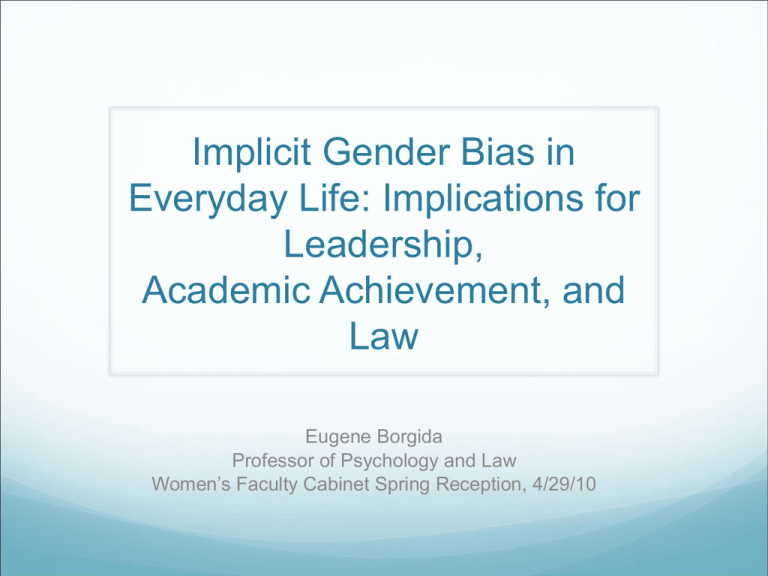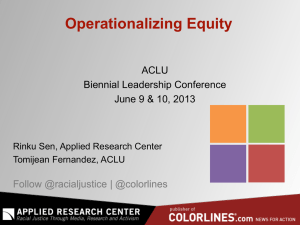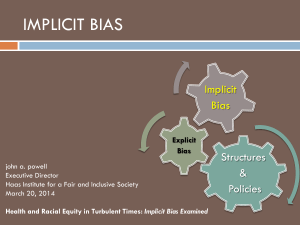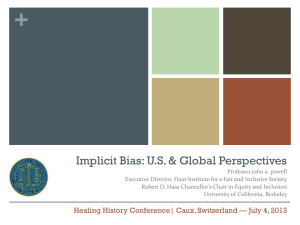
Implicit Gender Bias in
Everyday Life: Implications for
Leadership,
Academic Achievement, and
Law
Eugene Borgida
Professor of Psychology and Law
Women’s Faculty Cabinet Spring Reception, 4/29/10
Overview
Legal context – Title VII and “motivating factors”
The science of implicit bias
Implicit gender bias: role congruity theory, women and
leadership, STEM and implicit gender bias
Remedies
Legal context – Title VII and “motivating factors”
Eveleth Mines HR Director: “All women should be barefoot and pregnant.”
Legal context – Title VII and “motivating factors”
Title VII: it is an “unlawful employment practice for an
employer…to discriminate against any individual…, because
of such individual’s race, color, religion, sex, or national
origin.”
1991, Congress: “an unlawful employment practice is
established when the complaining party demonstrates that [a
prohibited characteristic] was a motivating factor for any
employment practice, even though other factors also
motivated the practice.”
Legal context – Title VII and “motivating factors”
Desert Palace, Inc. v. Costa: (2003): member of a protected
group, suffered as a result of a negative employment
decision, membership in protected group was a motivating
factor in that decision.
Congress did not define “motivating factors” under Title VII.
Do only consciously held and explicit motives qualify?
Intentional not the same as explicit. Strict or broad
interpretation?
“Behavioral realism” in the law (Krieger & Fiske 2006)
Legal context – Title VII and “motivating factors”
“Motivating factors” as consciously accessible.
(1) False assumption about the accuracy of self-reports
(Nisbett & Wilson, 1977). Decision maker may be
unaware that sex of applicant or maternal status
influenced their judgments.
(2) False assumption about the honesty of self-reports.
Decision makers may not be able to accurately
reconstruct process of thinking about how motivating
factors drove their evaluations; instead rely on
heuristic thinking.
The science of implicit bias
The science of implicit cognition is grounded in decades of research in
cognitive and social psychology showing that people’s expectations based
on learned contingencies unknowingly affect everyday perceptions,
judgment, memory, and behavior. Schemas drive our perceptions.
Mental processes about individuals and groups, as this work suggests, can
operate implicitly, or outside of conscious, attentional focus.
This is the psychological science foundation for understanding implicit
bias - the idea that we do not always have conscious, intentional control
over the processes of social perception, impression formation, and
judgment that motivate our actions.
The science of implicit bias
Greenwald & Krieger (2006):
“Implicit biases are discriminatory biases based on implicit attitudes or
implicit stereotypes. Implicit biases are especially intriguing, and also
especially problematic, because they can produce behavior that diverges
from a person’s avowed or endorsed beliefs or principles” (p.951).
Implicit gender bias
Gender stereotypes: women are kind, communal, care
about others, pay attention to emotions. Men are
agentic, task-oriented, have leadership qualities
(Eagly’s 1987 social role theory; Eagly & Karau’s 2002
role congruity theory of gender prejudice; Ridgeway’s
2001 status characteristics theory).
Explicit and implicitly endorsed. Variety of response
latency tasks used to measure these implicit gender
stereotypes. Both men and women associate gender
stereotypic trait-role pairings more quickly and
automatically.
Implicit gender bias
Faigman et al (2008):
“Studies have used a variety of different methodologies
and converged on the common finding that implicit
gender stereotypes emerge in people’s judgments and
decisions when measured in ways that bypass decision
makers’ awareness of potential bias” (p.1410).
Robust scientific literature: years of research attention,
different research paradigms, different labs, multimethod. Can educate triers of fact.
Implicit gender bias
Psychological “fit” between gender stereotypes and role
stereotypes: Women and leadership.
Gender prejudice emerges from the clash of gender
stereotypes and work role expectations -- role
incongruity or lack of fit.
Leadership roles are equated with masculinity. Female
leaders are evaluated as less leader-like than their
male counterparts. Backlash against female leaders.
Bias against full-time workers who are also caregivers.
Hoobler, Wayne, & Lemmon (2009)
Sample of male and female middle managers (n=52)
and reporting subordinates (n=126) in a Midwestern
division of a global Fortune 100 transportation
company.
Survey research to examine social role theory idea that
women, more so than men, are viewed from a
nonwork, caregiving perspective, and that their
nonwork demands will be more salient to workplace
colleagues.
Hoobler, Wayne, & Lemmon (2009)
Importance of managers’ perceptions of family-work conflict
(controlling for actual family-work conflict responsibilities) –
the “perception-promotability relationship” – “whether
women’s promotability is hampered by their bosses’
perceptions that they experience greater family-work conflict
than men and thus have poorer fit with their organizations
and jobs” (p.951).
“Think leader, think male” stereotype (V.A. Schein, 1973,
1975). Being a woman still associated with less effective
leadership (Eagly, Johannesen-Schmidt, & van Engen,
2003) and fewer attributes for organizational success
(Heilman & Haynes, 2008).
Hoobler, J.M., Wayne, S.J., Lemmon, G. (2009). Bosses' perceptions of family-work conflict and women's
promotability: Glass ceiling effects. /Academy of Management Journal/, /52/ (5), 939-957.
STEM and implicit bias
Stereotypes that men are more talented in math and
science are thought to influence STEM aspirations and
achievements of boys & girls, men & women. Implicit
associations between male & science, and female &
liberal arts for men and women. People may be
unaware of these implicit stereotypes or they may not
wish to reveal that they endorse them.
Women who endorse such stereotypes report less
interest in math and science, less likely to pursue a
math or science degree (Schmader et al 2004).
STEM and implicit bias
Reminding women of the “math=male” stereotype or subtly
priming or highlighting gender is enough to weaken their
performance on a subsequent math or engineering exam
(compared to a control group; Spencer, Steele & Quinn,
1999).
This is known as social identity threat (Steele, 2010, “identity
contingencies”). Seems to occur via elevated anxiety (and
increased cognitive load due to this anxiety) that one’s own
behavior will potentially confirm a stereotype about one’s
group (Steele 1997; Steele, Spencer & Aronson 2002).
Reappraisal of anxiety predicts better performance even
under threat – told that anxiety will not harm performance as does teaching about stereotype threat (Schmader 2010).
Remedies
I. What do we learn from the research on prejudice reduction?
Prejudice Reduction: What works? Best assessment of
research and practice (Paluck & Green, 2009)
PR = “a causal pathway from an intervention (e.g., a peer
conversation, a media program, an organizational policy, a
law) to a reduced level of prejudice.”
Remedies
Review of 985 studies (72% published) on prejudice
reduction (racism, homophobia, ageism, ethnic and religious
antipathy, overweight, disability, but not gender). Multimethod database, and wide range of interventions (from the
contact hypothesis to media campaigns to diversity training
to antibias education and sensitivity training).
Note: sex-based prejudice reduction interventions were
excluded. Rationale: the process of change and what are
successful remedies with regard to gender bias may be
different.
Remedies
Paluck & Green (2009) conclusions:
1. Causal effects of many prejudice-reduction interventions
“remain unknown.” We do not know (yet) what works.
2. Extended intergroup contact and cooperative learning
interventions appear promising but more rigorous empirical
assessment in order. Former can reduce outgroup hostility,
increase perspective-taking; the latter can be a tool for
breaking down ingroup/outgroup boundaries.
3. Until gender-based interventions are independently
evaluated, one should be careful about generalizing ideas
directly from one to another domain. Be guided by evidence
in Table 1.
Paluck & Green (2009)
http://www.betsylevypaluck.com/
Remedies
II. Awareness still matters
In Hoobler, et al (2009), managers should be made aware of
their potential to hold these implicit stereotypic biases.
Also making sure that employees signal to managers that
they are experiencing work-life conflict. Not without risk of
underscoring stereotypic perceptions. Leslie, Manchester
and colleagues at Carlson School – it depends on
managers’ perceptions of motive for use of FWP.
STRIDE at Michigan – faculty across the sciences, overview
of implicit gender bias research.
Remedies
III. Accountability
Kalev, Dobbin & Kelly (2008): effective accountability and
oversight structures in organizations centralize
authority for diversity, and the presence of such
structures also makes diversity training and evaluations
more effective.
Building accountability into a wide range of institutional
practices and policies.
Remedies
To address implicit gender bias, you need awareness,
changes in policies and practices, and leaders who are
willing to hold people accountable.







